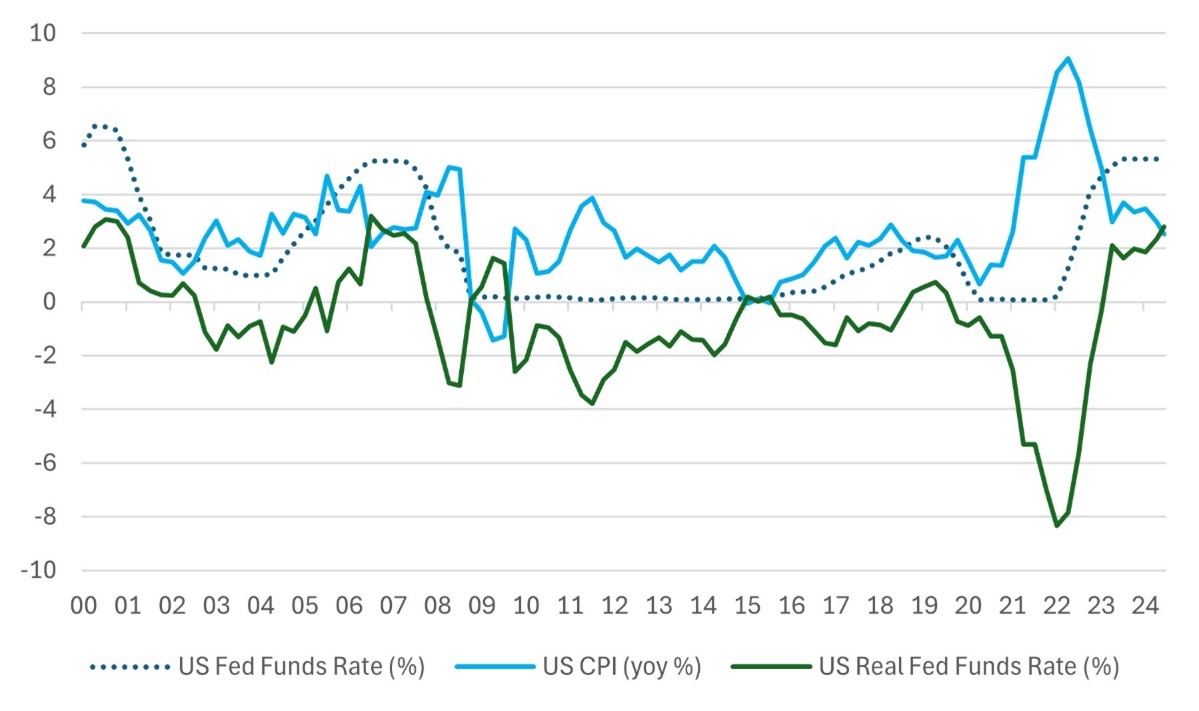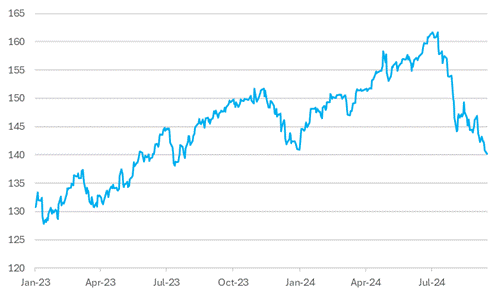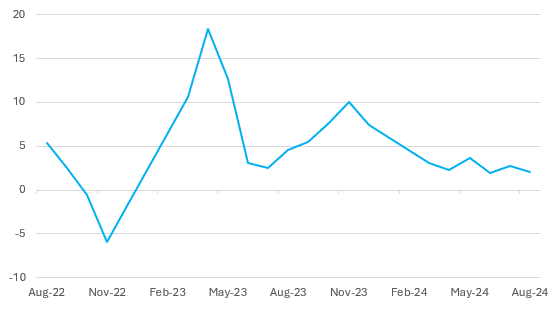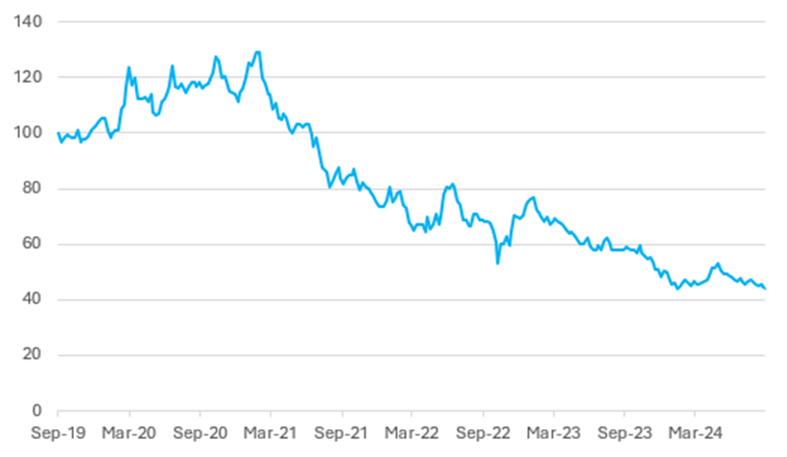By Falco
16 Sep 2024
• We are hopeful that the Fed will deliver a 50bps rate cut, if not the market will likely be disappointed
• A new Fed 'dot plot' should forecast a steady drop in policy rates over the coming 15 months
• The Bank of Japan to signal further rate rises, but no move likely at this meeting
• The UK MPC doesn't have a consensus for a rate cut but should find scope by the end of the year
• In China, it doesn't get any better with the authorities way behind in offering suitable support
Central banks are very much in the headlines this week, with the interest rate setting meetings of the Federal Reserve, the Bank of England and the Bank of Japan.
Fed Meeting – we favour a 50bps cut
As of this weekend, the market is pricing in a 57% probability of a 25bps rate cut and a 43% probability of a 50bps rate cut. While not all economic data supports a larger 50bps cut, the Fed may opt for a bold move due to the historically high real interest rates. The current Fed funds rate, adjusted for inflation, is 2.5%—the highest since 2007. In contrast, inflation in 2007 rose rather than fell (Chart 1).
If the Fed's goal is to bring real rates down to +50bps, this would imply a target Fed funds rate of approximately 2.75%, based on a 2.25% inflation target. Achieving this would require a total rate cut of 250bps. At a pace of 25bps cuts per meeting, the Fed could take roughly a year to reach its desired target.
The meeting will also see the release of the Fed's new dot plot, which shows where the Fed expects interest rates to move over the medium term. The Fed governors have been notoriously poor at forecasting rate changes over the past two years. We expect they will indicate that rates will be lower by 100bps at the end of the current year and close next year at around 2.75%. The market expects the Fed's estimate for inflation over the forecast period to remain unchanged. However, unemployment rate forecasts are likely to rise in the wake of the weaker data and the comments of concerns from Fed Chair Jerome Powell at the Jackson Hole meeting.
Chart 1: US Nominal and Real Fed Funds Rate

Source: Bloomberg
Bank of Japan meeting – managing market expectations
The market is not expecting any rate changes at this week's Bank of Japan meeting. However, the market is expecting BoJ guidance on when the next rate may occur. The BoJ will be keen to avoid any action or comments that re-create the marked volatility in the currency and asset markets seen in August.
With the risk of a US recession in the markets’ eyes now diminished, the BoJ’s focus will instead be on the pace at which the Japanese economy shows sustained inflation. We believe that a further rate rise towards normalisation is possible by December. Last week’s revision to Q2 GDP data still showed the Japanese economy still running at around a 3% pace and recent wage settlements have shown consistency of outcomes of wage growth around 3-5%. The one factor that could slow the pace of BoJ tightening is the weakness of the Chinese economy; recent economic data shows some weakness in large manufacturing company business confidence.
Chart 2: Yen/$ recovery

Source: Bloomberg
Bank of England - standing pat, but biased to ease in coming months
After the Bank of England's monetary policy committee's 5-4 vote on a rate cut at the last meeting, it is difficult to see the Bank of England cutting rates again at this week's meeting. We expect them to cut rates again before the end of the year, given that growth remains relatively benign, and inflation is under better control. At the Jackson Hole meetings, the Bank of England Governor, Andrew Bailey expressed his ongoing concern that the job is not quite yet done to bring inflation under reasonable control in the UK economy. However, should there be better inflation data? Then, with the backdrop of relatively flat GDP growth, there would be a good case for a further 25 basis point cut in interest rates at a subsequent meeting.
Taylor Swift holds up UK rate cuts? For Taylor Swift fans we note that her concerts in the UK have had the effects of biasing inflation higher than would ordinarily be the case due to higher hotel prices charged around the timing of her concerts. Hence this week’s inflation news could be biased to a higher level and give the MPC another reason not to cut!
China's Equity Market: Increasingly Uninvestable
China’s equity market is becoming ever more challenging for investors, as the gap between economic reality and the potential for meaningful government support continues to widen. Over the weekend, economic data releases painted a picture of sluggish growth. Industrial output for August rose by 4.5%, falling short of market expectations of 4.8%, and marking the weakest performance since March. Retail sales were similarly disappointing, growing just 2.1% in August, below analysts' expectations of 2.5%. This is particularly notable, as August typically sees a surge in consumer spending due to peak summer travel.
Chart 3: China’s Disappointing Retail Sales Growth

Source: Bloomberg
Adding to the concerning outlook, Friday’s bank lending figures showed a significant shortfall. New loans totaled 900 billion yuan, missing market estimates of 1 trillion and down sharply from last year’s 1.3 trillion yuan.
Ahead of these data releases, Chinese Premier Xi Jinping called on all levels of government to support the country's growth ambitions. Monetary policy adjustments, such as cutting the reserve requirement ratio, are likely to be among the first steps authorities may take to stimulate the economy.
Market sentiment towards China remains uncertain. As of late August, foreign investors had withdrawn $12 billion from Chinese equities since June, and the government has since restricted the publication of regular capital flow data.
Moreover, the trend of investors seeking emerging market benchmarks that exclude China is gaining traction. According to a February report by the Financial Times, U.S. retail investors are increasingly favoring ETFs that exclude China. Over the past year, assets in China-excluded EM ETFs have tripled to $5.3 billion, while China-focused ETFs saw outflows of $800 million.
President Xi Jinping’s leadership style, often described as steadfast, has drawn criticism for its delayed decision-making—most notably in lifting COVID-19 lockdowns. While long-term economic strategies focusing on high-tech industries, electric vehicles, and renewable energy are promising, they have yet to address China’s short-term growth challenges, particularly in the real estate and local government sectors.
Chart 4: China’s Equity Market Struggling Badly

Source: Bloomber
We remain sceptical about the potential for Chinese equities to perform, especially considering that even domestic investors have been pulling their money from the market in recent quarters. It appears that a significant intervention from the government will be necessary to reverse this trend. A combination of aggressive growth support policies and targeted funds injected into the equity market may be the only near-term solution.
However, even with such measures, we doubt that foreign investors will return swiftly to a market that could be perceived as ‘artificially’ propped up. The uncertainty is compounded by broader concerns, including the outcome of the upcoming U.S. Presidential election and the possibility of a substantial increase in tariffs under a renewed Trump presidency.
For Asian markets, the problems in China represent something of headwind to performance. However, the prospect of 100bps off US policy rates by year end will provide a good support. Asian central banks are set to follow the Fed with rate cuts particularly give the bias of the dollar to weakness.
Gary Dugan - Investment Committee Member
Bill O'Neill - Non-Executive Director & Investor Committee Chairman
16th September 2024
The information contained within is for educational and informational purposes ONLY. It is not intended nor should it be considered an invitation or inducement to buy or sell a security or securities noted within nor should it be viewed as a communication intended to persuade or incite you to buy or sell security or securities noted within. Any commentary provided is the opinion of the author and should not be considered a personalised recommendation. The information contained within should not be a person's sole basis for making an investment decision. Please contact your financial professional at Falco Private Wealth before making an investment decision. Falco Private Wealth are Authorised and Regulated by the Financial Conduct Authority. Registered in England: 11073543 at Millhouse, 32-38 East Street, Rochford, Essex SS4 1DB
